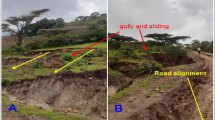Abstract
Landslide hazard zonation is essential for planning future developmental activities. At the present study, after the preparation of a landslide inventory of the study area, nine factors as well as sub-data layers of factor class weights were tested for an integrated analysis of landslide hazard in the region. The produced factor maps were weighted with the analytic hierarchy process method and then classified into four classes—negligible, low, moderate, and high. The final produced map for landslide hazard zonation in Golestan watershed revealed that: (1) about 53.85 % of the basin is prone to moderate and high threats of landslides. (2) Landslide events at the Golestan watershed were strongly correlated to the slope angle of the basin. It was observed that the active landslide zones, including moderate to high landslide hazard classes, have a high correlation to slope classes over 30° (R 2 = 0.769). (3) The regions most susceptible to landslide hazard are those located south and southwest of the watershed, which included rock topples, falls, and debris landslides.













Similar content being viewed by others
References
Akgün A, Bulut F (2007) GIS-based landslide hazard for Arsin–Yomra (Trabzon, North Turkey) region. Environ Geol 51(8):1377–1387
Ayalew L, Yamagishi H (2005) The application of GIS-based logistic regression for landslide susceptibility mapping in the Kakuda-Yahiko Mountains, Central Japan. Geomorphology 65(1–2):15–31
Ayalew L, Yamagishi H, Ugawa N (2004) Landslide susceptibility mapping using GIS-based weighted linear combination, the case in Tsugawa area of Agano River, Niigata Prefecture, Japan. Landslides 1(1):73–81
Carrara A, Crosta G, Frattini P (2008) Comparing models of debris-flow susceptibility in the alpine environment. Geomorphology 94(3–4):353–378
Çevik E, Topal T (2003) GIS-based landslide susceptibility mapping for a problematic segment of the natural gas pipeline, Hendek (Turkey). Environ Geol 44(8):949–962
Dai FC, Lee CF, Li J, Xu ZW (2001) Assessment of landslide hazard on the natural terrain of Lantau Island, Hong Kong. Environ Geol 43(3):381–391
Eastman JR, Jin W, Kyem PAK, Toledano J (1995) Raster procedures for multi criteria/multiobjective decisions. Photogramm Eng Rem Sens 61(5):539–547
Ercanoglu M, Gokceoglu C, Van Asch THWJ (2004) Landslide hazard zoning north of Yenice (NW Turkey) by multivariate statistical techniques. Nat Hazard 32(1):1–23
Lee S (2005) Application of logistic regression model and its validation for landslide hazard mapping using GIS and remote sensing data. Int J Remote Sens 26(7):1477–1491
Malczewski J (1999) GIS and multicriteria decision analysis. Wiley, New York, 408 pp
Mansouri Daneshvar MR, Bagherzadeh A (2011) Landslide hazard zonation assessment using GIS analysis at Golmakan watershed, northeast of Iran. Front Earth Sci 5(1):70–81
Neaupane KM, Piantanakulchai M (2006) Analytic network process model for landslide hazard zonation. Eng Geol 85:281–294
Remondo J, Gonzalez-Diez A, Teran JRD, Cendrero A (2003) Landslide susceptibility models utilising spatial data analysis techniques, a case study from the Lower Deba valley, Guipuzcoa (Spain). Nat Hazard 30(3):267–279
Roth RA (1983) Factors affecting landslide susceptibility in San Mateo County, California. Bull Assoc Eng Geol 4:353–372
Saaty TL (1980) The analytical hierarchy process. McGraw Hill, New York, 350 pp
Saaty TL, Vargas LG (2000) Models, methods, concepts, and applications of the analytic hierarchy process. Kluwer, Boston, 352 pp
Saboya F, Alves MG, Pinto WD (2006) Assessment of failure susceptibility of soil slopes using fuzzy logic. Eng Geol 86(4):211–224
Süzen ML, Doyuran V (2004) A comparison of the GIS base landslide susceptibility assessment methods: multivariate versus bivariate. Environ Geol 45(5):665–679
Yalcin A (2008) GIS-based landslide susceptibility mapping using analytical hierarchy process and bivariate statistics in Ardesen (Turkey): comparisons of results and confirmations. Catena 72(1):1–12
Acknowledgment
We thank the Islamic Azad University—Mashhad branch for its generous support of the project. We also thank the anonymous reviewer for constructive suggestions on the data analyses and interpretations.
Author information
Authors and Affiliations
Corresponding author
Rights and permissions
About this article
Cite this article
Bagherzadeh, A., Mansouri Daneshvar, M.R. Mapping of landslide hazard zonation using GIS at Golestan watershed, northeast of Iran. Arab J Geosci 6, 3377–3388 (2013). https://doi.org/10.1007/s12517-012-0583-9
Received:
Accepted:
Published:
Issue Date:
DOI: https://doi.org/10.1007/s12517-012-0583-9




